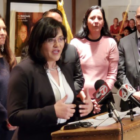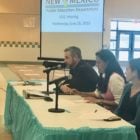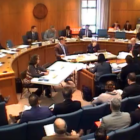Education
Lt. governor’s next education frontier: out-of-school-time learning
|
Lt. Gov. Howie Morales visits Las Cruces on a recent October morning to talk about his after-school learning initiative. Lt. Gov. Howie Morales was running late to an interview at the IHOP in Las Cruces.
His job these days puts him on the road a lot, but he still likes to drop his kids off at school in Silver City. That connection is something the former coach, special education teacher and state senator wants to keep with education in general.
“Education is always going to be at the heart of what I do because that’s why I got into public service,” he said on a recent October morning during a visit to Las Cruces, where he talked up a summit planned for Tuesday in Albuquerque on after-school and out-of-school time activities that would strengthen kids’ connections to school and provide more learning opportunities. As a senator, Morales got involved in the full spectrum of education, from preschool to higher education. He credited early educators in Grant County for making him understand a successful higher education system started with strong early education such as home visiting and preschool.









